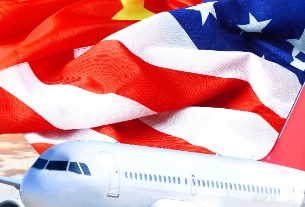Shanghai, China - Seventy-year-old Wang Zhenghua, founder and chairman of Spring Airlines, China's largest low-cost carrier, has a simple but effective way to keep prices down: Every day after work he asks his employees to turn off the lights before commuting back home.
China's government is planning to build 82 new airports as part of its five-year aviation plan
This could easily pass for a regular, international practise - if only his subordinates weren't also required to clean their offices themselves and use the cafeteria's second-hand microwaves during lunch breaks instead of eating out.
No matter how strict, this cost-cutting strategy has proven beneficial to Spring Airlines, China's first low-cost carrier (LCC). Founded in 2005 by the old-style Shanghai entrepreneur, the company carried a record 11 million passengers in 2013, as travelling on the cheap becomes the next big trend in China's booming tourism industry.
"It doesn't matter how many guidelines you give to your employees," Wang says in a meeting room in the company's headquarters, which is located in a grim, nondescript former 1980s hotel next to Shanghai's Hongqiao airport.
"Low-cost is a concept, a spirit, a culture that has to trickle from the senior management all the way down to the base."
But today Wang must go beyond cost controlling if he wants to stay ahead in this new but thriving industry. Over the past 18 months, several newcomers have joined the low-cost carrier market after the central government in Beijing unleashed a new set of policies in an unprecedented move last year to boost China's huge aviation market, the world's second largest behind the United States.
By 2015, 82 new airports will be built in China, according to the current five-year plan, while 415 million Chinese are expected to fly at least once a year within their country by 2016, according to forecasts from the International Air Transport Association (IATA).
New opportunities
Excited by the success of Spring Airlines, new start-ups are now looking for their piece of the pie. HNA Group - which holds Hainan Airlines, the country's fourth-largest airline - transformed its subsidiary West Air, a former namesake full-service airline, into a budget carrier at the end of 2012. Based in Chongqing, in southwestern China, West Air operates a fleet of 15 aircraft reaching 18 cities across China, mostly second and third-tier destinations in the inner provinces.
The latest company to join the bandwagon is Jiuyuan Airlines, which decided instead to base itself in Guangzhou, southern China's busiest hub. The new entity was founded in April by Shanghai tycoon Wang Junjin.
A member of the National People's Congress, China's rubber-stamp parliament, Junjin invested 414 million yuan ($66m), accounting for 69 percent of the registered capital of the joint-venture, according to a statement posted on its website. The company has committed to buy 50 aircrafts from Boeing, a deal worth more than $6bn.
The late arrival of low-cost carriers marks a significant change for China. Passengers here have long been left out of cheap flights, a business model pioneered in the US several decades ago but which never really took off in China, partly because of government measures.
"Until recently there was an effective prohibition on new carriers, following an expansion around 2006. In addition to that, LCCs had neither been explicitly welcomed nor shunned. This left them in limbo," says Will Horton, an analyst at CAPA Centre for Aviation, a research institute based in Sydney, Australia.
Meanwhile, China kept supporting the "Big Three" of the country's aviation industry, via subsidies and access to profitable routes. State-owned Air China, China Southern Airlines, and China Eastern Airlinestogether carried 247 million passengers last year, according to their websites.
But now even these state players, analysts say, could launch their own low-cost carriers. If China Eastern converts, as planned, its wholly owned subsidiary China United Airlines into a LCC, the company will then become the first Beijing-based, low-cost carrier to operate from the Chinese capital.
Policy-wise, the big change came in November 2013, when the Civil Aviation Administration of China removed the minimum pricing requirements that, until then, prevented China's LCCs from fixing the price of their domestic air tickets below a certain level.
The goal of the move was twofold: catch up with Southeast Asia, where low-cost carriers such as Malaysia's Air Asia have been seizing market share; and boost the local economy as China experiences a slowdown.
"Regulators have spoken of encouraging LCCs in under-developed air markets like in western China. GDP is lower there, meaning there is less support for full-service airlines and premium cabins. Efficient low-cost carriers could stimulate traffic," says Horton.
Economic turbulence
Efficiency, however, is not easy to achieve for these new entrants. While Spring Airlines became profitable in 2006, the company still has trouble securing prime slots and cutting turnaround time. The company flies to 49 destinations from its headquarters in Shanghai, yet Wang Zhenghua cannot get prime slots to land at Beijing Capital Airport.
Low-cost carriers are changing the way Chinese travel [Reuters]
"I applied the very first year to get one slot in the morning, and one slot in the afternoon. I am still waiting, this is not fair," Wang says. "But this is just a matter of time."
Other difficulties include recruiting experienced pilots able to fly in crowded airspace controlled by the military.
"The corridor between Shanghai and Beijing, it's like hell," says Matthieu Devoisselle, an independent aeronautics consultant based in Shanghai.
For now Spring Airlines' customer base includes mostly young travellers such as Eva Mao. This 27-year-old woman flew with Spring Airlines on June 8 from Shanghai to Siem Reap, Cambodia.
"Nine-hundred ninety-nine yuan ($160) including return plane ticket and hotel, this was a very good deal," says Mao, who bought the package on Taobao.cn, China's biggest e-commerce travel platform.
"People in China fly with Spring Airlines because it's cheap. Space between seats is limited and there's no food on board, but when you are young and want to travel, who really cares about that?"
China's low-cost carriers biggest challenge will be to expand beyond this new generation of price-sensitive Chinese consumers who will have more expectations as they travel, both domestically and internationally.
On Sina Weibo, China's Twitter-like micro-blogging service, many other white-collar workers are less enthusiastic about their country's LCCs.
"I will never take Spring Airlines again. I wasn't given any food and I had to pay 300 yuan ($48) for my overweight luggage," wrote Tony_Tai Ji after flying on June 10 from Chongqing to Shanghai. "What a pity."
Read the original article




